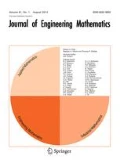Abstract
Statistical models are presented to describe the evolution of the surface roughness of polishing pads during the pad-conditioning process in chemical-mechanical polishing. The models describe the evolution of the surface-height probability-density function of solid pads during fixed height or fixed cut-rate conditioning. An integral equation is derived for the effect of conditioning on a foamed pad in terms of a model for a solid pad. The models that combine wear and conditioning are then discussed for both solid and foamed pads. Models include the dependence of the surface roughness on the shape and density of the cutting tips used in the conditioner and on other operating parameters. Good agreement is found between the model, Monte Carlo simulations and with experimental data.
Similar content being viewed by others
References
1._ A. S. Lawing, Polish rate, pad-surface morphology and pad conditioning in oxide chemical mechanical polishing. In: S. Seal, R. L. Opila, C. Reidseme Simpson, K. Sundaram, H. Huff and I. I. Suni (eds.), Proc. of the Fifth International Symposium on Chemical Mechanical Polishing, Philadelphia, PA, May 12–17, 2002. The Electrochemical Society Proc. Vol. PV2002–1 (2002) 46–60.
L. Borucki, Mathematical modeling of polish rate decay in chemical-mechanical polishing. J. Engng. Math. 43 (2002) 105–114.
B. Bhushan, Introduction to Tribology. New York: John Wiley and Sons, Inc. (2002) 732pp.
J. A. Williams and Y. Xie, The generation of wear surfaces by the interaction of parallel grooves. Wear 155 (1992) 363–379.
S. Jacobson, P. Wallen and S. Hogmark, Correlation between groove size, wear rate and topography of abraded surfaces. Wear 115 (1987) 83–93.
J.M. Steigerwald, S.P. Murarka and R.J. Gutman, Chemical Mechanical Planarization of Microelectronic Materials. New York: John Wiley and Sons, Inc. (1997) 324pp.
J. A. Murdock, Perturbations: Theory and Methods, volume 27 of Classics in Applied Mathematics. Philadelphia: Society for Industrial and Applied Mathematics (SIAM) (1999) 509pp.
J. A. Greenwood, A unified theory of surface roughness. Proc. R. Soc. London A 393 (1984) 133–157.
J. A. Greenwood and J. B. P. Williamson, Contact of nominally flat surfaces. Proc. R. Soc. London A 295 (1966) 300–319.
J. A. Greenwood and J. J. Wu, Surface roughness and contact: an apology. Meccanica 36 (2001) 617–630.
N. Yu and A. A. Polycarpou, Contact of rough surfaces with asymmetric distribution of asperity heights. J. Tribology 124 (2002) 367–376.
W. Feller, An Introduction to Probability Theory and its Applications, Vol II, 2nd ed. New York: John Wiley & Sons Inc. (1971) 669pp.x
Author information
Authors and Affiliations
Rights and permissions
About this article
Cite this article
Borucki, L.J., Witelski, T., Please, C. et al. A theory of pad conditioning for chemical-mechanical polishing. Journal of Engineering Mathematics 50, 1–24 (2004). https://doi.org/10.1023/B:ENGI.0000042116.09084.00
Issue Date:
DOI: https://doi.org/10.1023/B:ENGI.0000042116.09084.00


